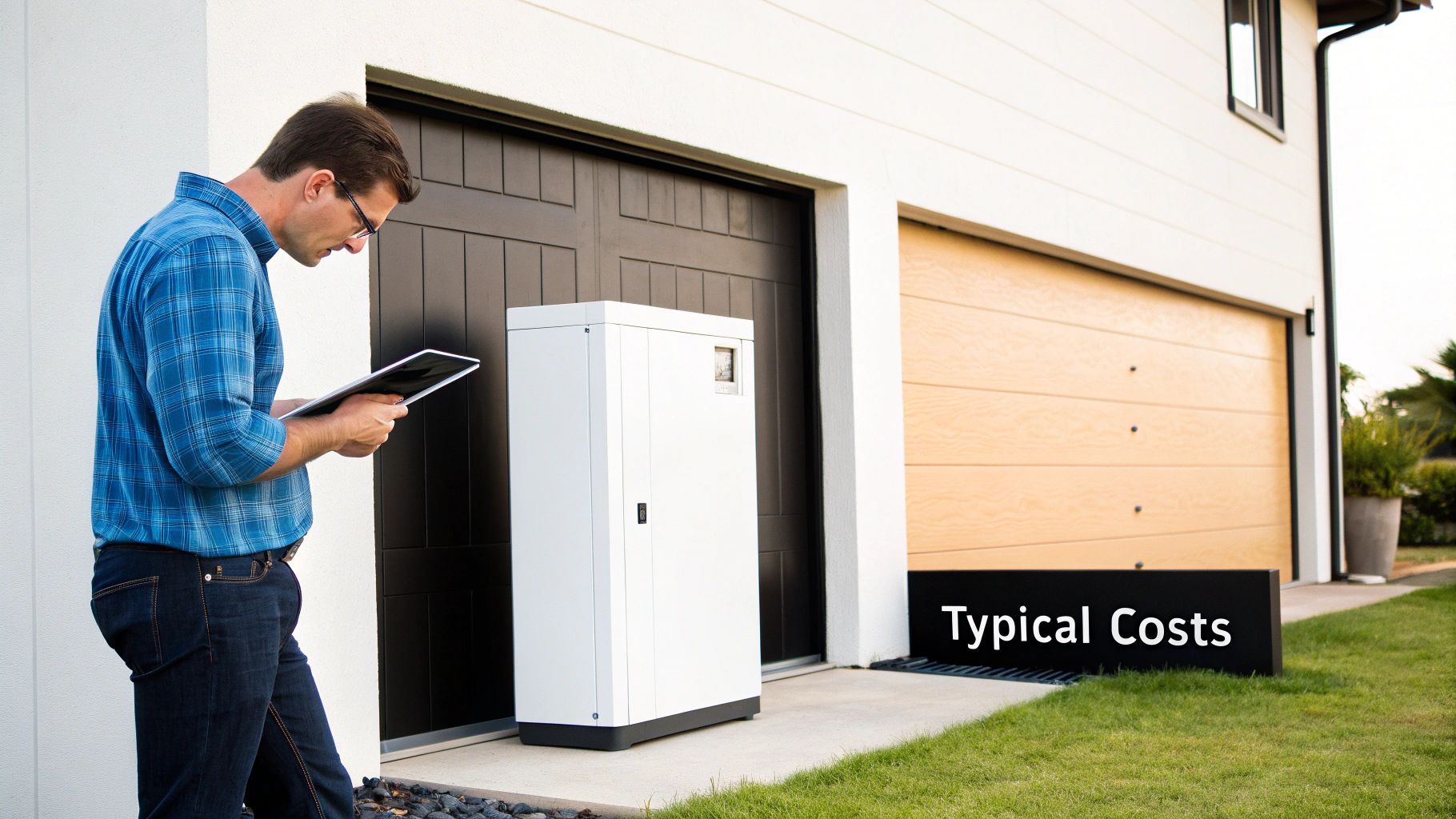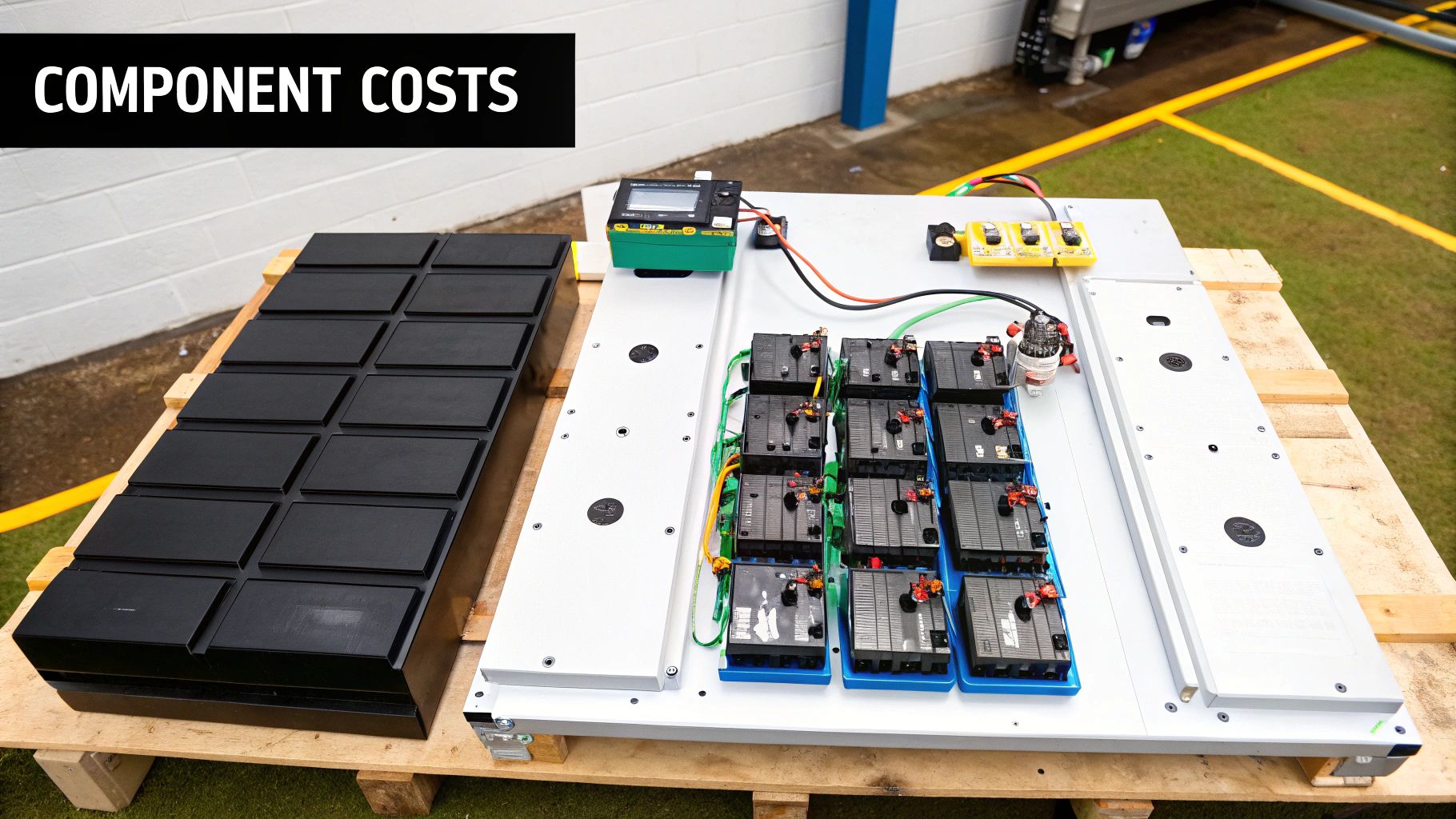
Whole Home Battery Backup Cost: A 2024 Guide for Homeowners & Installers
Share
For homeowners, installers, and project developers, understanding the real whole home battery backup cost is the first step toward energy resilience. The final installed price typically falls between $10,000 and $35,000. This guide provides a direct, no-fluff breakdown of the hardware, labor, and sizing decisions that determine your final investment, ensuring you can budget, quote, and build with confidence in today's market.
This article delivers actionable insights for:
- Homeowners: To set realistic budgets and understand the value of professional installation.
- Installers & Contractors: To create accurate, transparent quotes that build client trust.
- EPCs & Developers: To factor in real-world component and labor costs for project bids.
A Clear Financial Snapshot of Home Battery Backup

Forget vague estimates—let's look at the actual cost drivers shaping your total project price. Understanding the numbers is critical whether you're a homeowner planning for energy independence or an installer preparing a client quote. The total cost is more than the battery unit; it's a combination of capacity, brand, and installation complexity.
Critical Cost Drivers for Budgeting
Getting a handle on these key factors early helps set realistic expectations for any project.
- Battery Capacity (kWh): This is the single biggest cost factor. A smaller 10 kWh system designed to keep essentials like a refrigerator and router online will be significantly more affordable than a 30 kWh+ system capable of running an entire home, including HVAC and EV chargers.
- Brand and Technology: Tier 1 brands like FranklinWH, BYD, and Sungrow command different price points based on their technology (e.g., LFP vs. NMC chemistry), warranty terms, and proven field performance.
- New Install vs. Retrofit: Adding a battery to an existing solar array (an AC-coupled retrofit) can sometimes be more complex and require more labor than installing an integrated solar-plus-storage system from scratch (a DC-coupled system).
Current market pricing for a complete system starts around $10,000 and can exceed $50,000 for high-capacity, multi-unit installations. For a detailed breakdown of pricing tiers, you can discover more details on these battery backup costs to see how they apply to specific project scopes.
Estimated Whole Home Battery Cost Tiers
This table provides a practical starting point for aligning project needs with a realistic budget. These are all-in installed costs, covering equipment, professional labor, and permitting.
| System Tier | Capacity (kWh) | Estimated Installed Cost | Best For (Use Case) |
|---|---|---|---|
| Essential Backup | 10–15 kWh | $10,000 – $20,000 | Keeping critical loads running: refrigerators, lights, well pumps, medical devices, and internet. |
| Partial Home | 15–25 kWh | $20,000 – $35,000 | Powering essentials plus some high-draw comfort appliances like a mini-split AC or small appliances. |
| Full Independence | 25+ kWh | $35,000+ | Achieving near off-grid capability, running central HVAC systems, EV chargers, and all household electronics. |
Pro Tip for Installers: For faster, more accurate quoting, use our bundled kits. Portlandia Electric Supply offers pre-matched battery, inverter, and BOS packages that reduce sourcing time, guarantee component compatibility, and streamline logistics for your projects.
Decoding the Price Tag of Your Battery System

To accurately calculate the whole home battery backup cost, you must look beyond the battery's sticker price. A complete, code-compliant system is an ecosystem of critical components, each contributing to the final project cost. For installers, breaking this down builds client trust; for homeowners, it clarifies exactly what they're paying for.
The all-in installed price for most residential systems lands between $6,000 and $23,000. This range covers the battery, inverter, labor, and all balance-of-system hardware. Due to advances in manufacturing, the cost per kilowatt-hour (kWh) for lithium-ion technology has fallen to a more accessible $200 to $400. You can explore more insights on 2025 energy storage pricing to see where the market is heading.
The Core Hardware Components
A reliable backup system is an engineered solution designed for performance, safety, and compliance with standards like the NEC (National Electrical Code).
- The Battery Unit: The heart of the system and the largest line item. Brands like FranklinWH, BYD, and Sungrow offer various capacities (kWh) and chemistries (LFP is the current standard for safety and longevity), which directly dictates price.
- The Inverter: The system's brain, converting DC battery power to AC household power. A high-quality hybrid or storage inverter is critical for efficiency, reliability, and grid interaction capabilities.
- The Transfer Switch: The safety gatekeeper. An automatic transfer switch (ATS) is essential for safely isolating your home from the grid during an outage and connecting it to battery power, often so quickly the transition is seamless.
- Balance-of-System (BOS) Hardware: The crucial connective tissue—wiring, conduit, circuit breakers, and mounting racks. These are non-negotiable for a safe, UL-listed, and code-compliant installation and are a significant cost component.
Compliance Watchout: A common mistake is underestimating BOS costs. Using undersized wiring or non-compliant components to save money is a major safety risk and will fail inspection. Always budget for high-quality, code-compliant hardware from the start.
Installation and Labor: The Other Half of the Equation
The price of the battery unit is just the starting point. When budgeting for a whole home battery backup, skilled labor is a major component, often representing 25% to 50% of the total project cost. This is a complex electrical installation that demands licensed professionals to ensure safety, performance, and code compliance.
The final labor cost depends heavily on site-specific conditions. A straightforward installation in a new home with a modern electrical panel may take one to two days. An older home requiring a main service panel upgrade and complex conduit runs could become a multi-day project.
What Drives Up Installation Costs?
Every project is unique, which is why a thorough site assessment is non-negotiable before providing a final quote.
- Job Complexity: A maxed-out electrical panel requiring a service upgrade is a common and significant cost adder. Long conduit runs between the battery location (e.g., garage) and the main panel also increase labor and material costs.
- Permitting and Inspection: Local Authority Having Jurisdiction (AHJ) fees for electrical permits are a required part of the process. Depending on the municipality, these can range from a few hundred to over a thousand dollars.
- Required Expertise: A licensed electrician is the minimum requirement. For solar-paired systems, a NABCEP-certified professional is the gold standard, ensuring the entire system is designed and installed to meet all NEC and utility interconnection standards.
How to Structure Your Quote for Transparency
For installers, a detailed, itemized quote is a powerful tool for building trust. Clearly separate the costs for hardware, labor, permits, and any required electrical upgrades. This transparency justifies the investment and demonstrates professionalism.
Pro Tip for Homeowners: When reviewing a quote, look for specifics. A quality proposal will list the exact brand and model of the battery, inverter, and transfer switch. It will also explicitly state that all work will be permitted and inspected. Vague quotes are a red flag.
How System Sizing Impacts Your Total Investment
When determining your final whole home battery backup cost, no decision is more critical than sizing. Sizing too small results in a system that fails during an outage. Sizing too large means paying a premium for capacity you will never use.
The process starts with a detailed load calculation to determine what you truly need to power when the grid is down. This analysis will guide you toward one of two primary design strategies.
Essential Loads vs. Whole-Home Backup
Understanding the difference between these two approaches is fundamental for budgeting and system design.
- Essential Loads Backup: The most common and cost-effective approach. You select critical circuits—refrigerator, freezer, well pump, internet, specific lights, and medical devices—to be moved to a protected loads sub-panel. This keeps the battery size manageable (typically 10-15 kWh) and controls the upfront investment.
- True Whole-Home Solution: For seamless energy independence. This system is designed to power everything, including high-draw appliances like central HVAC, electric ranges, and EV chargers. This requires a much larger battery bank, often 25 kWh or more, and a more robust inverter, significantly increasing the total cost.
This choice directly impacts the complexity and cost of the electrical installation.
Essential vs. Whole-Home Sizing Comparison
| Backup Type | Typical Loads Covered | Example Daily Usage (kWh) | Recommended Battery Size (kWh) |
|---|---|---|---|
| Essential Loads | Refrigerator, Freezer, Lights, Internet, Sump Pump | 5-8 kWh | 10-15 kWh |
| Whole-Home | All circuits, including HVAC, Electric Range, EV Charger | 20-30+ kWh | 25-40+ kWh |
Critical Mistakes: Capacity (kWh) vs. Power (kW)
A critical mistake we see is focusing only on a battery's storage capacity (kWh) while ignoring its continuous and peak power output (kW). A 13.5 kWh battery may have enough stored energy, but its 5 kW power output might not be enough to start a 3-ton AC unit that requires a 7 kW surge. This results in the system tripping precisely when you need it. Always verify that the battery's power rating can handle the starting current (inrush) of your largest motors. For a deeper dive into these technical considerations, see our guide on designing home battery backup systems.
Using Incentives to Reduce Your Upfront Cost

The initial whole home battery backup cost can be intimidating, but the sticker price is rarely the final price. A combination of federal, state, and utility incentives can significantly reduce your net investment, making energy resilience far more accessible.
The Federal Clean Energy Credit (ITC)
The most significant incentive is the Residential Clean Energy Credit, also known as the Investment Tax Credit (ITC). This provides a tax credit for 30% of the total cost of qualifying solar and battery storage systems. This is a dollar-for-dollar credit against your federal tax liability.
- Paired Systems: If you install a battery with a new solar array, the entire project cost (panels, battery, inverter, labor) is eligible for the 30% credit.
- Standalone Batteries: Under the Inflation Reduction Act, you can now claim the 30% credit for a standalone battery system (3 kWh capacity or more) even without solar panels.
For the most current details, always consult official guidance or the latest solar tax credit information.
State and Local Utility Rebates
Many states and utilities offer their own rebate programs that can be stacked with the federal ITC.
Pro Tip for Installers & Developers: Before quoting any project, consult the DSIRE database (Database of State Incentives for Renewables & Efficiency). Programs like California's Self-Generation Incentive Program (SGIP) or incentives from NYSERDA in New York can dramatically improve project ROI for your clients. Portlandia Electric Supply provides full compliance support for these programs, ensuring your projects qualify.
These incentives often have limited funding, so timely application is key. The combined savings can reduce the payback period for a solar-plus-storage system to as little as 5–15 years. Our guide on adding battery storage for home solar provides more detail on maximizing these financial benefits.
Common Questions About Home Battery Costs
When evaluating the whole home battery backup cost, practical questions inevitably arise. Here are direct answers to the most common queries from homeowners and professionals.
How Long Will a Home Battery Last During an Outage?
Runtime depends on two factors: the battery's capacity (kWh) and your home's real-time energy consumption (kW). A 13.5 kWh battery could run essential loads (refrigerator, lights, internet) for over 24 hours. However, running a central air conditioner could drain that same battery in just 3-4 hours. Effective load management during an outage is key to maximizing runtime.
Can I Add a Battery to My Existing Solar Panel System?
Yes. This is called an "AC-coupled" retrofit and is a common installation. A new battery system with its own inverter is connected to your home's main electrical panel. A qualified electrician can ensure the new components integrate properly with your existing solar hardware, adding backup power and storage capabilities without replacing your current array.
Expert Insight for Project Developers: While AC-coupling is effective for retrofits, a "DC-coupled" system (where solar and battery share a single hybrid inverter) is generally more efficient for new installations. It reduces energy conversion losses, maximizing the solar energy stored and used.
What Is the Real Long-Term ROI of a Home Battery?
The ROI is both financial and functional. Financially, batteries enable time-of-use arbitrage—storing cheap off-peak energy to avoid expensive peak-rate electricity from the utility. This, combined with incentives, can lead to a payback period of 5–15 years.
Functionally, the ROI is immediate resilience. For a homeowner, it's the peace of mind that medical devices will stay on and food won't spoil. For a business, it's avoiding thousands in lost revenue from downtime. The value of uninterrupted power during an emergency is often priceless. Our analysis of a home battery backup vs. a generator provides a full cost-benefit breakdown.
Are There Ongoing Maintenance Costs I Should Plan For?
This is a key advantage of modern battery systems over generators. Systems using Lithium Iron Phosphate (LFP) chemistry are virtually maintenance-free.
- No Fuel Costs: They charge from the grid or solar.
- No Moving Parts: No oil changes, spark plugs, or engine servicing.
- Silent Operation: They operate silently, unlike noisy generators.
Once installed by a professional, there are no significant ongoing maintenance costs, making the total cost of ownership highly predictable.
At Portlandia Electric Supply, we provide the Tier 1 hardware, NABCEP-certified design support, and streamlined logistics to ensure your energy storage projects are successful and profitable. Whether you're an installer quoting a residential job or a developer planning a commercial project, we are your dedicated project partner. Request a Quote today to leverage our in-stock inventory and expert support.
